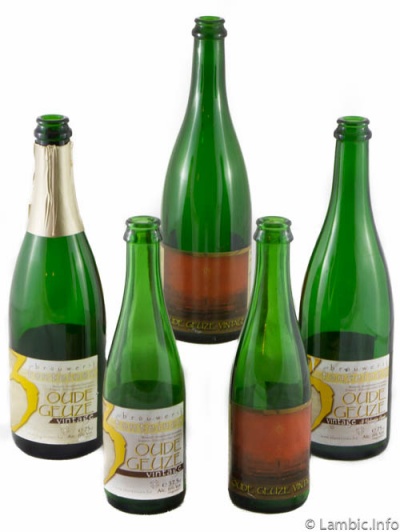3 Fonteinen Oude Geuze Vintage

Description
Ouce Geuze Vintage is 3 Fonteinen's reserve series geuze. Unlike regularly released 3 Fonteinen Oude Geuze, which is widely distributed in Europe and North America, Oude Geuze Vintage is limited to local distribution, primarily within Belgium. It is stored within the cellars at 3 Fonteinen and released several years later instead of being released after the typical maturation period of six months for the regularly released Oude Geuze. It is released in both 375 mL and 750 mL bottles and is labeled as 6% ABV.
Clarification on Oude Geuze and Oude Geuze Vintage
A common question among lambic enthusiasts is, “are Oude Geuze and Oude Geuze Vintage different beers?”
Both beers are brewed and blended to initially be released as Oude Geuze. The decision to identify if the beer will be released as Oude Geuze Vintage occurs as it develops and is at the brewery’s discretion.
According to the brewery, the process of brewing and blending what becomes their standard geuze remains the same throughout the season. However, each time a standard blend is bottled there is a chance that the brewery will decide to hold a portion of, or the entire blend, back for release at a later date beyond the customary 6-month bottle refermentation period. The process for selecting what will become Oude Geuze Vintage is based on observations by the brewery as to how the beer is progressing from the time of bottling. This could be based on taste, perceived aging potential, or a need for more time in the bottle.
Thus, no blend and subsequent bottling of standard geuze from 3 Fonteinen specifically starts out as Oude Geuze Vintage, and each bottling has the potential to be released as such in the future.
History / Other Notes
3 Fonteinen Oude Geuze Vintage was first bottled in the spring of 2002. This year is also the most prolific year in terms of batches released. Subsequent years have varied in terms of individual bottling dates and bottling sizes. All labels have featured either the common yellow 3 Fonteinen label with the word "vintage" or the red Felix De Boeck "Nightlights" label (explained below). The only exception to this is the February 14, 2007 label that reads St. Valentijn Cuvée.
St. Valentijn Cuvée
On February 14, 2007, Armand bottled a blend of Oude Geuze Vintage as well as the original batch of Hommage. Because of the fruit aromas (and bugs) in the brewery and the fact that it was Valentines day, Armand nicknamed this Oude Geuze Vintage batch "St. Valentijn Cuvée." The February 14, 2007 bottling was labeled with both the regular vintage yellow label and the "Nightlights" label, as well as with a unique label that reads St. Valentijn Cuvée. Both synthetic corks and natural corks were used for this bottling.
Synthetic Corks
The earliest known use of a synthetic cork by Drie Fonteinen is a regular Oude Geuze 750ml bottling from February 3, 2006. The November 30, 2006 750 mL bottling of Oude Geuze Vintage has a synthetic cork as well as most of the February 14, 2007 St. Valentijn Cuvée bottling. Consumers have noted that the Oude Geuze Vintage bottles with the synthetic corks have been inconsistent, with some bottles being flat and oxidized. The synthetic cork was retired from use after the St. Valentijn Cuvée bottling.
Bottle Log
Label Log
-
Oude Geuze Vintage Felix de Boeck "Nightlights" Label
-
Oude Geuze Vintage, 75cl
-
Oude Geuze Vintage, 37,5cl
-
Artwork used for the 2014 OGV 375ml label
-
New "Nightlights" label for 2016 OGV introduced in 2019
-
Inside of 2016 OGV label
-
Inside of 2016 OGV label
-
Artwork used for the 2016 OGV 375ml label
Felix de Boeck "Nighlights" Label
Felix de Boeck (1898-1995), born in Drogenbos (Flemish Brabant), is regarded as one of the founders of abstract painting in Belgium in the 1920s. De Boeck continued to work on his family farm painting only on Sundays throughout this life. Following a visit to Antwerp in 1950, de Boeck began a series of paintings entitled Nachtlicthen (Nightlights) which depict a "decentralization and fragmentation of the light source inside a clear geometric structure." This series would be interspersed with other paintings throughout the rest of his career.[1] As a nod to a hometown artist, 3 Fonteinen uses this label for some of its Oude Geuze Vintage releases as well as for the 50th Anniversary Oude Geuze from 1998.
The gallery below is a representation of Nachtlichten spanning de Boeck's career. In 1995, shortly before his death, Felix de Boeck laid the foundation stone for the FeliXart Museum in Drogenbos which opened in 1996. The museum is housed in a modern building that was constructed next to the farmhouse where he lived. The museum houses many of de Boeck's works today as well as other contemporary exhibitions and is located approximately two miles from 3 Fonteinen.
-
Nachtlichten (land, water en lucht), 1950
Source: Mutual Art -
Nachtlichten (lucht en water), 1953
Source: Mutual Art -
Nachtlichten, 1954
Source: Artnet -
Nachtlichten- Beersel, Drogenbos, Ruisbroek, 1954
Source: FeliXart -
Nachtlichten, 1957
Source: Artnet -
Nachtlichten, 1958
Source: Artnet -
Nachtlicthen Beersel, 1970
Source: Mutual Art -
Nachtlichten Drogenbos, 1976
Source: Artnet -
Nachtlichten Drogenbos, 1977
Source: Artnet -
Nachtlichten Drogenbos, 1980
Source: Artnet -
Nachtlichten Drogenbos, 1980
Source: Artnet -
Nachtlichten, title/date unknown.
Source: Mutual Art